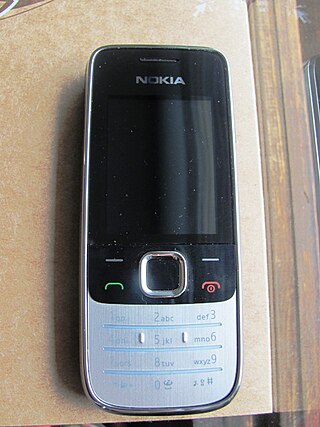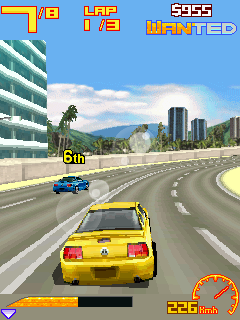Java Platform, Micro Edition or Java ME is a computing platform for development and deployment of portable code for embedded and mobile devices. Java ME was formerly known as Java 2 Platform, Micro Edition or J2ME. As of December 22, 2006, the Java ME source code is licensed under the GNU General Public License, and is released under the project name phoneME.
Mobile Information Device Profile (MIDP) is a specification published for the use of Java on embedded devices such as mobile phones and PDAs. MIDP is part of the Java Platform, Micro Edition framework and sits on top of Connected Limited Device Configuration (CLDC), a set of lower level programming interfaces. MIDP was developed under the Java Community Process. The first MIDP devices were launched in April 2001.
The Connected Device Configuration (CDC) is a specification of a framework for Java ME applications describing the basic set of libraries and virtual-machine features that must be present in an implementation. The CDC is combined with one or more profiles to give developers a platform for building applications on embedded devices ranging from pagers up to set-top boxes. The CDC was developed under the Java Community Process as JSR 36 and JSR 218.
The Connected Limited Device Configuration (CLDC) is a specification of a framework for Java ME applications describing the basic set of libraries and virtual-machine features that must be present in an implementation. The CLDC is combined with one or more profiles to give developers a platform for building applications on embedded devices with very limited resources such as pagers and mobile phones. The CLDC was developed under the Java Community Process as JSR 30 and JSR 139.

Binary Runtime Environment for Wireless was an application development platform created by Qualcomm, originally for code division multiple access (CDMA) mobile phones, featuring third-party applications such as mobile games. It was offered in some feature phones but not in smartphones. First developed in 1999, as a platform for wireless applications on CDMA-based mobile phones, it debuted in September 2001. As a software platform that can download and run small programs for playing games, sending messages, and sharing photos, the main advantage of Brew MP was that the application developers can easily port their applications among all Brew MP devices by providing a standardized set of application programming interfaces. Software for Brew MP enabled handsets can be developed in C or C++ using the freely downloadable Brew MP software development kit (SDK). The BREW runtime library is part of the wireless device on-chip firmware or operating system to allow programmers to develop applications without needing to code for system interface or understand wireless applications. BREW is described as a pseudo operating system, but not a true mobile operating system. BREW was not a virtual machine such as Java ME, as it runs code natively.
Java APIs for Bluetooth Wireless Technology (JABWT) is a J2ME specification for APIs that allows Java MIDlets running on embedded devices such as mobile phones to use Bluetooth for short-range wireless communication. JABWT was developed as JSR-82 under the Java Community Process.
The Mobile Media API (MMAPI) is an API specification for the Java ME platform CDC and CLDC devices such as mobile phones. Depending on how it is implemented, the APIs allow applications to play and record sounds and video, and to capture still images. MMAPI was developed under the Java Community Process as JSR 135.
A Technology Compatibility Kit (TCK) is a suite of tests that at least nominally checks a particular alleged implementation of a Java Specification Request (JSR) for compliance. It is one of the three required pieces for a ratified JSR in the Java Community Process, which are:

Java is a set of computer software and specifications that provides a software platform for developing application software and deploying it in a cross-platform computing environment. Java is used in a wide variety of computing platforms from embedded devices and mobile phones to enterprise servers and supercomputers. Java applets, which are less common than standalone Java applications, were commonly run in secure, sandboxed environments to provide many features of native applications through being embedded in HTML pages.
OMA Device Management is a device management protocol specified by the Open Mobile Alliance (OMA) Device Management (DM) Working Group and the Data Synchronization (DS) Working Group. The current approved specification of OMA DM is version 1.2.1, the latest modifications to this version released in June 2008. The candidate release 2.0 was scheduled to be finalized in September 2013.
Java Application Descriptor (JAD) files describe the MIDlets that are distributed as JAR files. JAD files are commonly used to package Java applications or games that can be downloaded to mobile phones. Java applications enable mobile phones to interact functionally with online web services, such as the ability to send SMS messages via GSM mobile Internet or interact in multiplayer games. Some BlackBerry devices use JAD files for themes, while on some mobile phones without memory cards it is not possible to download any apps.
The Location API for Java ME is a compact and generic Java 2 ME API that produces information about the device's present physical location to Java applications. This API can be optionally supported by mobile phone and PDA manufacturers, with the minimum Java platform required for this API being CLDC v1.1.
The Security and Trust Services API for J2ME (SATSA) is a collection of Java ME-based APIs that provides compliant devices with additional cryptographic security features. It permits the communication of a Java ME application with a smartcard through the APDU and Java Card RMI protocols. SATSA was developed under the Java Community Process as JSR 177.
Comparison of the Java and .NET platforms.
PDA Optional Packages for the J2ME Platform JSR 75 is a specification that standardizes access in the Java on embedded devices such as mobile phones and PDAs to data that resides natively on mobile devices. JSR 75 is part of the Java ME framework and sits on top of CLDC, a set of lower level programming interfaces. It has 2 main components. Not all devices that claim to implement JSR 75 will implement both components.
In computing, the Advanced Multimedia Supplements is an API specification for the Java ME platform. Practically speaking, it is an extension to JSR 135 Mobile Media API providing new features, such as positional 3D audio processing, audio and video effects processing, better controls for digital camera, and better support for analog radio tuner including Radio Data System. AMMS was developed under the Java Community Process as JSR 234.

The Nokia 2730 classic is a Nokia Quad-band GSM/UMTS 3G cell phone that includes a camera, FM radio, Bluetooth, music and video player, as well as several internet-based applications.

The Mobile 3D Graphics API, commonly referred to as M3G, is a specification defining an API for writing Java programs that produce 3D computer graphics. It extends the capabilities of the Java ME, a version of the Java platform tailored for embedded devices such as mobile phones and PDAs. The object-oriented interface consists of 30 classes that can be used to draw complex animated three-dimensional scenes. M3G was developed under the Java Community Process as JSR 184. As of 2007, the current version of M3G is 1.1, but version 2.0 is in development as JSR 297.

The Nokia Asha platform was a mobile operating system (OS) and computing platform designed for low-end borderline smartphones, based on software from Smarterphone which was acquired by Nokia. The platform inherits UI similarities mostly from MeeGo "Harmattan", and replaced Series 40 on Nokia's low-end devices. The user interface design team was headed by Peter Skillman, who had worked previously on webOS and the design of MeeGo for the Nokia N9.




